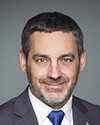Okay.
That actually puts you over your time.
Mr. Nantel, you have the floor.
Evidence of meeting #125 for Canadian Heritage in the 42nd Parliament, 1st session. (The original version is on Parliament’s site, as are the minutes.) The winning word was nunavut.
A recording is available from Parliament.
Liberal

The Chair Liberal Julie Dabrusin
Okay.
That actually puts you over your time.
Mr. Nantel, you have the floor.
NDP

Pierre Nantel NDP Longueuil—Saint-Hubert, QC
I want to thank all the witnesses.
This bill has led to fascinating discussions. Along with other witnesses, we've been discussing the bill introduced by my colleague, Romeo Saganash, with whom I have the privilege of working, and respect for the fundamental rights of Indigenous peoples.
I always say—I even heard it in the question asked by my colleague earlier—that there's an archeological perception of this issue. However, I think that we've been speaking more about the social sciences and a contemporary healing of the people whose past is involved. It's about your past and history. I think that we should address two issues, and I want to do so now.
First, we can start by saying that you're responsible for choosing how you want to repatriate, display and share these artifacts, with your people first, long before the artifacts are used as museum pieces and any cultural mediation with white people. You're responsible for choosing how you'll proceed. That said, the assignment of this responsibility without a proper budget constitutes a poisoned gift.
How should your control over the repatriation be included in the bill, and how should the cost be assessed? Shouldn't the cost be completely covered by the people who carried out all the actions that led to the current reconciliation commission, which means us and the rest of the country? In addition, why shouldn't the cost also be covered by people who benefited from the artifacts in their museums, archeological facilities or personal collections? I don't want to be too negative, but we must discuss money. Where will the money come from?
This question is specifically for Mr. Chartier and Ms. Kotierk or Ms. Gross.
President, Métis National Council
Well, that is a very excellent question and comment, because you're right. Without the necessary resources to enable us to find where the items are and to identify them as ours, those that we don't know of.... It will take resources.
I mentioned the museum in Manitoba. We've been working at that for over 30 years. The Manitoba Métis Federation took it on about 15 years ago, and we're getting close. In fact, we started with a stimulus budget, where we were asked to put in a proposal, but in the end the Métis nation didn't get a cent out of that stimulus budget. Through the years, it's been building up a little bit to where it is today, at the cusp of being able to move forward.
In our smaller communities, we don't have museums. For example, in northwest Saskatchewan, where I'm from, for the last 30 years I've been acquiring beadwork from our artisans, moose carvings and so on. I have them, but I have no place to put them yet. I'm thinking that, at some time, if the only place we can put them is in the national museum, then we can put them there, but it would be nice to have them right now in our community, so resourcing is a big issue.
We have the Gabriel Dumont Institute in Saskatoon, our educational arm in Saskatchewan, which has a small museum and also a virtual museum. They're going through this process but have challenges as well. Again, resources are a big challenge.
NDP

Pierre Nantel NDP Longueuil—Saint-Hubert, QC
Just adding to the question, maybe some of you heard about the cultural hub studies we've done here. Could there be a link between those, a cultural hub, funded, that can also accommodate these, according to your plans and your will?
This is for Ms. Kotierk or Ms. Gross.
President, Nunavut Tunngavik Inc.
Nakurmiik.
In terms of the costs, I mentioned that a Nunavut heritage facility has already been agreed to in our Nunavut agreement under article 33.2.4. One of our challenges is the non-implementation of our current agreements. I think that would be a venue in which monies could be allocated toward seeing something come to fruition. There are different types of money. There's money that would be needed for capital to create a facility, but in terms of operations and maintenance funds, I think the money that the territorial government currently uses to house the 140,000 artifacts outside Nunavut could be diverted to operations and maintenance.
The thing that we need to work on, first and foremost, is getting the capital dollars to create the facility within Nunavut. In addition to that, money would be required to ensure we're building capacity among the Inuit so that Inuit have the specialized technical skill set to be able to work in a heritage facility that is run by Inuit and that is based on Inuit world views.
I think those are the types of.... Right now, we're faced with repatriation of the 140,000 objects that already belong to us and that are housed outside of Nunavut. Once we have those housed, I think another aspect would be to look around to see what other Inuit objects are out there, but we're not even looking there yet.
Executive Director, Kitikmeot Inuit Association, Nunavut Tunngavik Inc.
Thank you for your question.
I really think that the Inuit Heritage Trust is encouraging the Government of Canada to demonstrate reconciliation by working with us to implement article 33.2.4 and to have a museum in the territory. We do have smaller museums. As I said, I work at one of them. It's a non-profit organization started by the community over 22 years ago.
We do want to celebrate who we are in our communities by going to museums. It has been a gracious gift that NTI and QIA have both pledged $5 million towards bringing home those artifacts that are housed at the Museum of Nature's storage and also at the Winnipeg Art Gallery.
We would really love to have those objects sooner rather than later, because our elders are passing more quickly than we know. Their shared knowledge of who we identify with as Inuit is rapidly passing. Along with each elder who is sadly leaving this Earth goes their knowledge and their wisdom. To have them be able to utilize those objects and look at them and teach us at home is most important.
Liberal

The Chair Liberal Julie Dabrusin
Unfortunately, that is the end of our time for this entire session.
If any of you have extra comments that you would like to send to us, you can do that, but I would ask that you do that soon because we will be looking at this bill shortly. If you have additional comments, please submit them.
Thank you to all of you. You've really added to our understanding of this bill and how we should be moving forward. That will bring this session to an end.
The meeting is adjourned.